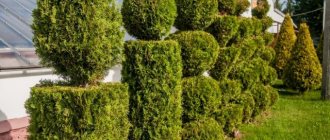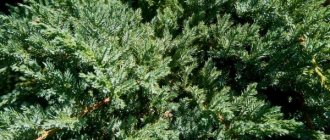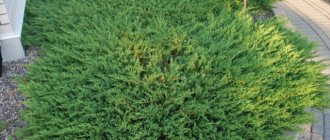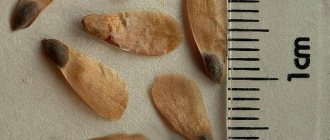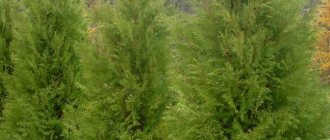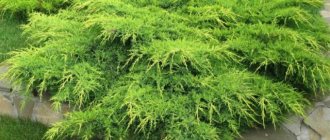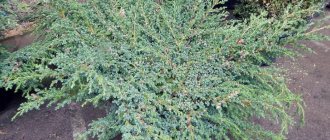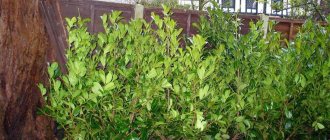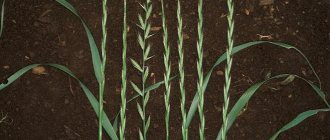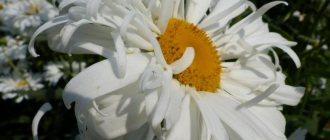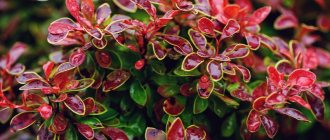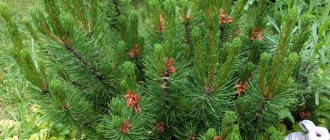09.09.2020 Cat scientist Nature Virginia juniper is a “native” of North America, classified in the Cypress family. This is a coniferous evergreen plant that prefers rocky places. Today, the plant is represented by several ornamental varieties that take root quite well in our country. In general, there are about 70 plant varieties.
Botanical description
Juniperus virginiana is a shrub. There are both monoecious and dioecious plants. The bush can reach a height of 30 meters, with a trunk thickness of 150 centimeters.
The needles of the bush have a dark green color. It is very small, no more than 2 millimeters, scaly.
From the first year of life, cones and berries appear on the bush, which give the plant an unusually attractive aesthetic appearance. During the ripening process, the fruits acquire an almost black color with a clearly visible bluish tinge.
Juniper is considered a long-liver; it can grow for 500 years.
Varietal diversity
Juniperus virginiana is represented in our latitudes by several species, namely:
- Gray Owl, with a maximum height of 4 meters, but on average often barely reaches 1 meter. During the growth process it forms a multi-tiered crown. The variety tolerates both drought and frost well.
- Glauca, with a spreading crown, capable of stretching up to 4 meters in 10 years of life. But the older the plant gets, the less attractive it is. In winter, the needles take on a purple hue.
- Juniperus virginiana Hetz. A variety that tolerates cold and heat well, is not afraid of direct sunlight and is undemanding to the soil.
- Skyrocket virginian. A distinctive feature of the variety is the ability to grow in the shade. It has soft needles, which turn brown in winter.
- Canaertii. The variety grows in areas with warm climates and has a loose crown.
- Golden Spring. This is a unique variety crossed from several different species. It does not grow higher than 50 centimeters, but the trunk can reach 1.5 meters in diameter.
Use in landscape design
Conifers occupy a special place in the garden. They allow you to create a flowerbed, the decorativeness of which is not lost with the change of seasons. Juniperus virginiana looks great both as a tapeworm and as a hedge. Some varieties do well in pots, forming a pointed crown (“arrowhead”), or forming dynamic cascades of greenery from low-growing varieties. Can be used in rockeries and alpine slides. The variety of shapes and colors will allow you to create a composition only from representatives of this species. But combined with contrasting foliage and perennial flowers it will look better.
Juniperus virginiana is an excellent species for sunny spaces, capable of maintaining decorative value for up to 40 years. According to some sources, it will not be able to overwinter at temperatures below 30 degrees and requires shelter. Otherwise, this is a beautiful tree with good decorative qualities and is a source of phytoncides.
Juniperus virginiana Hetz: description of the variety
This is an upright shrub with a spreading shape. It can reach a height of 2 meters with a width of 3 meters. Obtained as a result of crossing Chinese and Cossack varieties. Compared to other varieties, it is considered fast growing.
The needles have a bluish-gray tint, and in winter they can turn brown. The fruits are dark blue in color.
The shrub does not like shade and may even lose its natural color. Grows well in partial shade and direct sunlight.
Juniperus virginiana Hetz does not require special soil, but it cannot be compacted, it must be loose. In winter, it is recommended to tie the branches, as they are quite fragile and can break under the weight of snow. Ideal for creating hedges.
But the most important distinctive feature of the shrub is its abundant fruiting and wonderful aroma.
Landing in the ground
Under natural conditions, juniper reproduces by seeds, so-called self-sowing. At home, the plant is propagated by cuttings.
The species does not like moisture, so when choosing a place for planting, you need to pay attention to the proximity of groundwater and the presence of artificial water sources. For example, it is not recommended to plant along buildings, since when it rains, water will flow directly under the roots of the plant.
The planting site should be sunny; shade has an unfavorable effect on conifers: plant growth slows down, and the needles acquire a yellowish tint. The soil can be any; juniper is not picky about the composition of the soil.
As a rule, the crop has a long tap root; it is worth paying attention to the safety of the rhizome at the time of purchasing the seedling. The plant is planted without removing the soil in which it grew, this will increase the chances of taking root in a new place.
If you have to plant a seedling with bare roots, then it is preferable to do this in rain or cloudy weather, and ensure abundant watering in the first months. The root collar is not buried to provide the plant with oxygen.
Juniperus virginiana Hetz Variegata: description
Another interesting variety that grows quickly and takes root well in central Russia. Over the course of a year, the plant gains 20 centimeters in growth, that is, by 10 years the bush will stretch up to 1 meter. Tolerates urban conditions well and does not require special soil. It tolerates drought and frost equally well, down to -34 degrees. It tolerates haircuts well, but not replanting.
The needles have a greenish-bluish tint with very rare splashes of cream. It has a conical shape and a dense crown, which is ideal for formal gardens and hedges.
Advantages of the variety
Juniperus virginiana Hetz has many advantages over other varieties, but the most important thing is the beauty and decorativeness of the shrub.
Other benefits include:
Landing rules
It is better to purchase juniper virginiana Hetz in containers, so the young seedlings are ready for planting and will quickly begin to grow. It is best to plant the shrub in April, May or October, but be sure to immediately plant it in a place where it will grow continuously. If the plant has a closed root system, then it can be planted in open ground at almost any time of the year, naturally not in winter.
The plant must be planted together with the earthen ball with which it is sold. It is best to place bushes in well-lit areas. The main thing is to immediately create a composition, since replanting juniper is not recommended.
If the soil is heavy and/or clayey, then you should definitely put peat, sand or ordinary garden soil in the hole. It is recommended to drain the soil first. This is done very simply - broken bricks and sand are laid out at the bottom of the pit.
Introduction
Depending on what variety the juniper belongs to, it can be of a horizontal type, or it can be vertical and grow like a tree. The maximum lifespan of a certain variety and type of juniper can reach five hundred years. The height of the plant can be different - the largest and tallest junipers can reach a height of almost thirty meters, and for some varieties this height is far from the limit.
As a rule, as soon as the Virginian juniper becomes over forty years old, it can gradually lose its decorative qualities. The bush becomes less attractive, and usually after this it is completely removed from the garden plot or from the landscape where it has been located all this time.
There are fruits on the plants - as a rule, these are cones, which have a wide variety of colors. Most often, cone berries of a dark blue, almost black hue are found on Virginia junipers. Berries can stay on plants for a very long time, until severe frosts occur. This gives the juniper bush even more decorative and attractive, especially during the fruiting period. The root system of this variety of juniper is distinguished by its strength and the development of a large number of lateral branches. As a rule, it is due to its root system that the plant is so strong and, most importantly, it is in no way susceptible to strong gusts of wind.
The Virginia juniper's natural habitat is rocky terrain. Also, sometimes junipers take root well in swampy areas, especially in North America.
Today, breeders and agronomists have identified about seventy different types of juniper crops. All of them differ from each other in a number of basic characteristics: - the shape of the plant (shrub) - the height of the bush - dwarf, medium-sized or tall plants - the shade inherent in the needles and needles - other characteristics that may also differ depending on which variety refers to juniper.
In general, Juniperus virginiana is extremely popular today precisely because it is completely unpretentious and, at the same time, it is quite decorative, which is why it is so often used to decorate and decorate personal plots and even apartments. Junipers are usually propagated in three main ways: - seed method, which is not the most popular - grafting method - cutting method
Variety grafting is usually carried out only on the rarest varieties of juniper crops. Gardeners, especially experienced ones, recommend a third method of propagating juniper - cuttings. But even here it should be taken into account that there are some specific features and nuances that are best taken into account so that the plant grows strong, healthy and truly very decorative. So, if you do not care for the plant and do not take some preventive measures, then only half, and sometimes a small part, of the total number of cuttings can survive. But if the gardener follows agrotechnical rules and also uses drugs to stimulate plant growth, then you can get an excellent tendency for the plant to survive. As a rule, in this case, up to 80% of all cuttings that the gardener used in his activities take root.
It is best to choose a place for planting that is warm and well-lit; the soil should also warm up well. It must be equipped with drainage, which can be used as ordinary broken brick or expanded clay. If water accumulates and stagnates in the soil, this can lead to the formation of fungi and fungal diseases in the root system, which have a destructive effect on the plant. If the Virginia juniper experiences such stress, its growth will slow down noticeably, and in the future it will simply stop growing, die, and lose its decorative features.
Plants are planted either in autumn or spring. Due to the peculiarities of the development of the juniper root system, it is recommended to replant it together with a lump of earth without destroying it. Only in this case does the root system have a better chance of successfully adapting to new conditions. The landing pit should be no more than seventy centimeters deep. It is better to maintain a certain distance between seedlings, which ranges from half a meter to two meters, it all depends on the type of bush, its size and how the root system grows. The root collar can remain on the surface of the earth, since in this case the plant will be saturated with the necessary amount of oxygen, which is very important for juniper.
As for care measures, Virginia juniper, in principle, needs the most standard procedures, among which the following measures stand out in particular: - regular weeding, ridding the plant of any weeds - the soil around the plant must be regularly loosened so that it receives everything it needs amount of oxygen. It is oxygen that saturates the plant and allows it to develop in accordance with the norms - soil moisture. In this case, you can use both root application of moisture and spraying, since the green part of the plant also needs the gardener to spray it regularly. This will keep the juniper looking fresh. External moistening is best done either in the morning or in the evening, when the sun has already disappeared below the horizon - mulching the soil with straw and peat allows you to retain all the necessary amount of moisture in the tree trunk circle so that the plant feels as comfortable as possible
Feeding and watering
Sometimes in the photo the juniper virginiana Hetz does not look very attractive. It is possible that the reason lies in improper care. When the bush is still young, it needs moderate watering, but it should be done regularly. When the plant grows, watering is no longer required; juniper tolerates drought well. If the heat persists and lasts for quite a long time, then the bush can be sprayed, but only in the evening or early in the morning, then it will not lose its decorative appeal.
It is recommended in the spring (from April to May) to add a small amount of nitroammophoska to the soil in a proportion of 30-40 grams per area of 1 square meter.
Diseases and pests: treatment methods
Most often, junipers suffer from fungal diseases. A plant affected by rust begins to dry out, and thickenings appear on the branches. When ripening, the mushrooms cover the thickenings with mycelium, coloring them orange. This type of fungus requires two hosts, one of which can be an apple tree, pear tree or hawthorn. Another carrier is a conifer, such as juniper. You can save the plant by removing the affected branches with a sterile pruner and destroying them. The tool must be wiped with alcohol after use. Both fungal carriers must be treated with a fungicide.
The dry top of the tree indicates infection with fungi of the genus Fusarium. The tree's needles turn red, and the root system turns black: over time, gray spores form on it. The fungus from the root, through the vascular system, spreads throughout the plant, cutting off the supply of nutrients. The affected branches are removed “surgically” and the entire plant is treated with a fungicide. You can use Maxim, Topaz or Fitosporin. If possible, the soil under the plant must be replaced. But it is most likely impossible to save the plant; the damage comes from the root.
The cause of this disease is waterlogging of the soil. It is Virginia junipers that are more susceptible to this disease.
Pruning rules
According to reviews of juniper virginiana Hetz, the plant is very beautiful and does not require pruning at all. However, if you need to form a hedge, then you cannot do without such measures. When pruning a plant, remember that it retains its shape for a long time, so every mistake will “disturb” the eye.
Naturally, sanitization should be carried out regularly, the spreading ends of branches should be removed, and thinned out.
Winter care
Many gardeners use snow as cover, but this method is only suitable for small, young shrubs. If the plant is already tall or the winters have little snow, then it is better to make a protective frame. As a cover, you can use non-woven fabric, for example, kraft paper, which is laid in a double layer. The main thing is that the lower part of the crown is open.
Planting and caring for juniper virginiana Hetz involves covering the bushes from February to March. The plant is quite difficult to tolerate strong changes in the winter-spring period. Often in spring the nights are cold, and during the day the sun is already very hot, burning the crown of the plant. Daytime burns can cause a change in the color of the crown; it becomes brownish-yellow, and this already reduces its decorative appeal.
Reproduction
Propagating juniper with your own hands is considered an amateur activity, since you can buy any variety in any specialized store. However, people who like to create everything with their own hands should know that the plant can be propagated in three ways.
Cuttings. Cuttings should be made in the spring, choosing young but already lignified shoots. Their length should be from 5 to 7 centimeters, and the internodes should be at least 2. The main thing is that the stalk cannot be cut off, it must be torn off with a pull so that the heel remains.
The torn cutting should be immediately treated with a root formation stimulator and planted in the ground with:
All components are added in equal parts. The soil is sprinkled with coarse sand on top, and the cutting itself is covered with a glass jar. By autumn, roots should already appear.
Vaccinations. This method, as a rule, is used only if it is necessary to propagate a particularly valuable variety. You should follow the standard procedure, but as practice shows, this method is not popular among gardeners, since juniper has a very low survival rate.
Seed method. Usually, before planting seeds, they are subjected to cold treatment. After it, the plant rises within 4-5 months. If this is not done, the first shoots will appear only after 12 months. Seedlings can be planted in a permanent place only for the 3rd year after ascending, that is, the procedure requires a huge amount of patience.
How to propagate?
There are three ways to propagate juniper virginiana.
Propagation by seeds will produce a large number of healthy plants. Good seeds are found in dark colored fruits. To obtain seeds, ripe fruits are soaked and ground. The seeds are kept in a growth stimulator for 24 hours and another 30 minutes in a slightly acidic solution. Soil for coniferous plants can be purchased at the store and disinfected.
It is good to add soil from the place where junipers grow to the soil. In the ground there are symbiont mushrooms that are in “commonwealth” with coniferous trees and help in growth.
Seeds stored indoors require stratification, or they can be placed outside in a container, covered with spruce branches and snow. Young plants are in no hurry to appear; you may have to wait from 1 to 3 years. Young plants are planted in greenhouses or separate containers. Carefully monitor air and soil humidity. The plant can be planted in a permanent place at the age of three.
The second method of propagation is cuttings. Planting material is cut in February. You can plant cuttings before winter, but then they will have to be cut off in early June. This is necessary for the formation of roots: they will appear only in a month and the plant will need another two months to take root. But cuttings taken in early spring will take root and overwinter better.
How to take cuttings correctly?
- The cut must be made with a sterile instrument in cloudy weather or in the evening.
- Cut off the top green shoots. For representatives of horizontal varieties of Virginia juniper, these should be vertical shoots.
- The branches should be from 10 to 25 centimeters in length. The lower part of the trunk is cleared of pine needles and bark to 4 centimeters.
- The cuttings are planted in soil made of peat and humus to a depth of 2-3 centimeters. The distance between cuttings should be at least 50 centimeters.
- At the end of autumn, plants can be planted in a permanent place.
- The first year in a new place the plant requires watering and mulching. Shelter is required for the winter.
Reproduction by layering. This method is convenient only for creeping and horizontal varieties of Virginia juniper. To do this, the bush is watered abundantly and the soil is loosened. Add humus, peat, sand to the soil. The part of the trunk in the area of the internode is cleared of bark and pressed to the ground with pins. Layers are sprinkled with peat and humus on top.
Only next year, when the cuttings have their roots, can it be cut off from the mother plant.
There is another way to propagate rare species - grafting. A cutting of a rare species is grafted onto common juniper. This method does not allow you to get many plants and the survival rate is very low.
